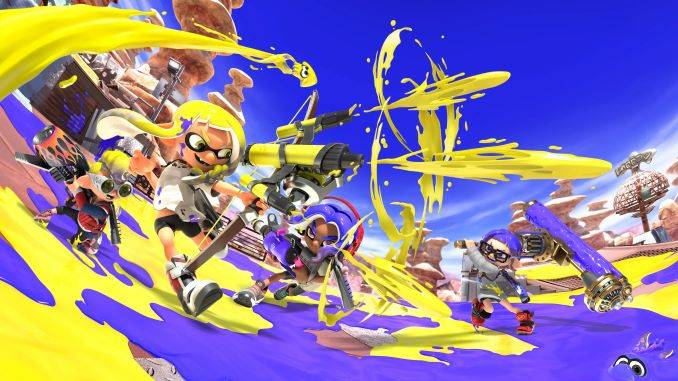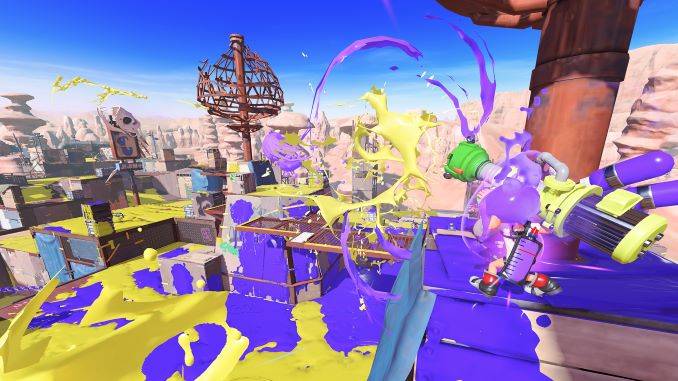
Being confined to solely Nintendo consoles until my teens, I had never experienced the euphoria that is wasting away hours while playing multiplayer games online with friends. Call me asocial or weird, but nothing about random matchmaking, clans, or prestige ever enticed me; why spend money on a game if you can’t enjoy it in solitude? Nintendo themselves tried to challenge this snobby attitude when they released Splatoon in 2015 for the Wii U (rest in peace my asymmetrical buddy, gone but not forgotten). Finally I was the prime demographic for an online shooter, and by that I mean I was someone who actually owned a Wii U.
Splatoon was bright and colorful, a third-person shooter full of punk spirit, fashionable clothes, and gallons of neon ink. Sure there was no voice chat, and yes the Wii U’s online capabilities were, to put it politely, limited, but it was a first-party online multiplayer game from Nintendo. A brand new frontier to conquer, or, well, attempt to conquer. Nintendo stumbled Splatoon, slowly molding it into a fleshed-out experience by the time Splatoon 2 launched in 2017, which itself burned hot for a moment before fizzling out after more games launched on the Switch. Third time’s the charm though, right?
Enter Splatoon 3, the second game in the series to grace the Nintendo Switch—or second and a half if you count the massive Octo Expansion DLC as its own mini-adventure. For a series that never set the world on fire, sales of the newest release have been absolutely bananas, particularly in Japan. The series is finally having its major moment, and having spent a full week trying to experience everything it has to offer, I can understand why: Splatoon 3 is simply more Splatoon. And with a half-decade gap between games, people are realizing that’s a good thing.
This isn’t exactly a hot take; dozens of reviewers slapped down an 8/10 and deemed the game as more of the same. That means more Squid, more Kid, and more messy battles though its diverse and incredibly enjoyable game modes. The multiplayer options—Turf Wars, the various types of Anarchy Battles, and the raid-like Salmon Run—are all taken from previous entries, but prove to be no less of a polished and chaotic time than they were originally. Even its single-player campaign—when it isn’t fumbling things like setting, level variety (those break the target levels, SO HELP ME GOD), or catchy music—provides an ample good-time.
None of that is what this article is going to focus on. Sorry! Look, if you’re reading this belated review to help inform you whether or not Splatoon 3 is worth your time and hard-earned money, I’ll save you from scrolling to the bottom of the page: If you liked the others, you’ll like this one, and if you didn’t, there’s not much here that will change your mind. Easy peasy octo squeezy. You’re welcome.

What interests me far more than droning on about the slick gameplay and bizarrely eye-catching paint drip physics is determining why everyone has deemed the lack of radical innovation a bad thing. “Sequels should be more of the same but different,” consumers screech, clutching their favorite media like pearls. Not different enough to challenge them, mind you—fanfolk still want everything they loved in the first place to remain recognizable and present. But, all the same, something should be different—a new villain, a new setting, a new mechanic or plot device or customization options.
Splatoon 3 has all of the above, yet people still moan and groan that it’s stagnant, a Xerox of a Xerox that should be interrogated as such. Yet dozens of series release new titles with little to no changes yearly, but since Splatoon 3 is developed by Nintendo, a company who puts fun and novelty above all else, it becomes an issue. And it’s to these people I must ask: what do you want to change? The core concept of Splatoon is incredibly strong, taking paintball fights to their logical endpoint with charming characters in a nonsensical world. Eight years in, I’d be hard pressed to say they’d wrung everything dry; each match I played was fun and enticed me into “just one more” far more often than I’d like to admit. The series’ precise, digestible action and myriad ways to experience both single-player and multiplayer may not keep people invested in the long-term, but are unstoppable when they’re the zeitgeist. So I have to repeat: what do you want Nintendo to change?
None of this is a pass for developers to simply copy and paste from game to game; thoughtful design and implementation are still required. It’s difficult to criticize an entire experience when it’s created through nearly invisible tweaks rather than outright reinvention. Turf War, Rainmaker, Salmon Run, all of these modes are simply refined versions of what we’ve already seen: Nothing is new but nothing is untouched either. When I grow tired of nearly 60 levels of the same single-player hijinx I’ve played two full games of already, someone else is experiencing them all for the first time. They won’t notice that movement feels slightly better, that the new weapons open up new strategies, that the paint looks nicer: all they care about is that the game is damn fun and they’re enjoying themselves.
I believe then that the vital distinction here is intention. Splatoon 3 does not intend to be a new experience. It wants to be a refresh, an update that becomes the platform for the foreseeable future of the series. It doesn’t try to be a sequel in the traditional sense, content instead with replacing the previous version rather than being in conversation with it. Now there is a discussion here to be had about whether or not sequels like Splatoon 3 should be sold at full price, which is valid and complex and not something I can adequately go into right now. I can confidently say, though, that it would be unfair to judge the game for being something it never claimed to be.
On its own merits, Splatoon 3 keeps everything funky fresh, providing yet another solid experience for Squid Kids to happily, even greedily, consume. It’s junk food, a sweet and savory snack that fills you up just the right amount to always want another bite. It might not nourish your body, but it nourishes your soul, each taste leaving yet another joyful memory. The wrapper may be different, but the insides are still the same consistent and sublimely tasty treat. You don’t mess with the perfect junk food; they changed the flavor of Coke once and it almost caused national riots.
Splatoon 3 was developed and published by Nintendo. It is available for the Switch.
Mik Deitz is a freelance writer and former Paste intern. They inhale stories in videogames, films, TV and books, and have never finished God of War (2018). Yell at or compliment them on Twitter @dietdeitz.